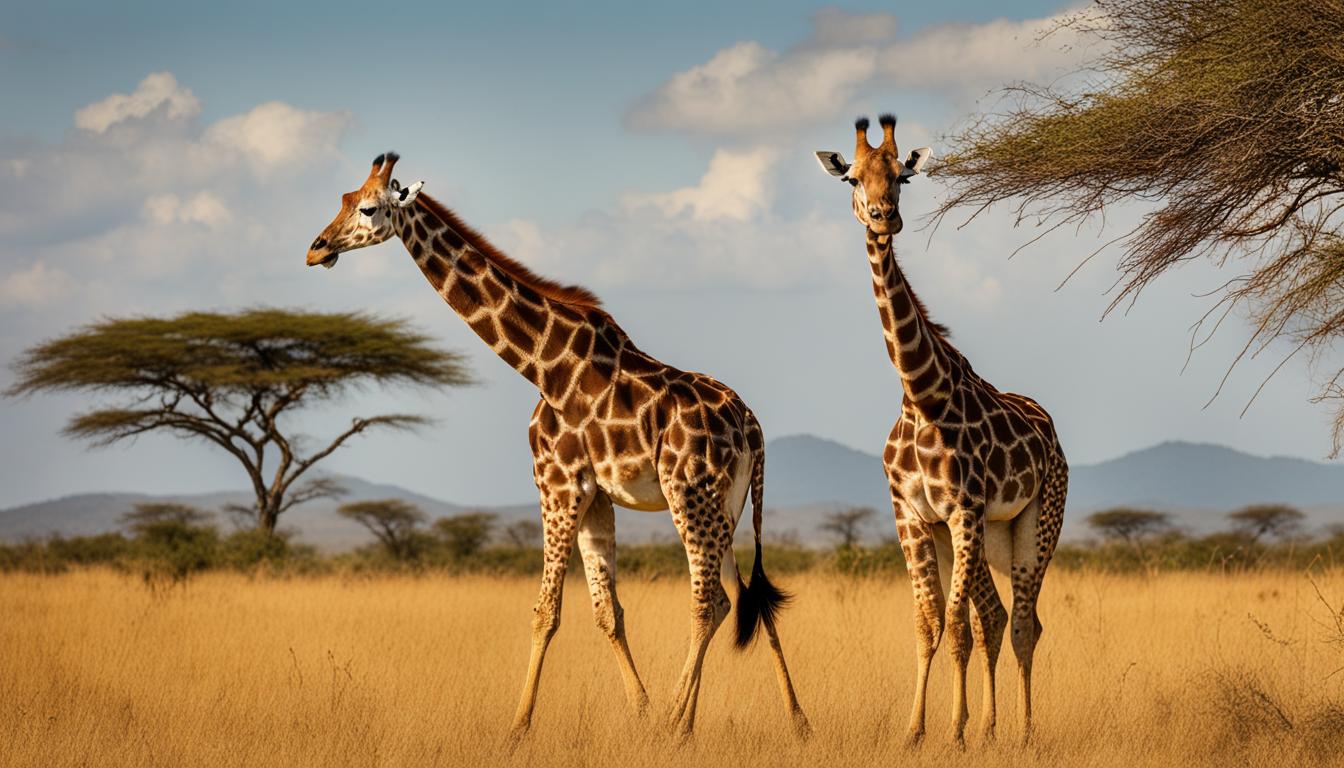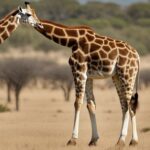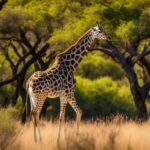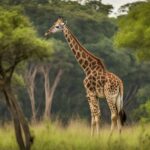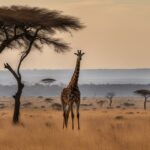Giraffes, one of nature’s most magnificent creatures, are unfortunately facing a multitude of challenges that threaten their existence. The population of giraffes has been declining rapidly in recent years, putting them at risk of becoming an endangered species. In this article, we will explore the critical conservation efforts that are being made to protect these gentle giants and ensure their survival for future generations.
Giraffe conservation organizations and wildlife conservation initiatives are at the forefront of the fight to save giraffes from extinction. Their primary focus is on protecting and preserving the natural habitats that giraffes rely on for survival. By safeguarding these habitats, we can provide giraffes with the necessary resources and space they need to thrive.
Habitat protection is just one part of the equation. Conservation strategies also involve addressing the immediate threats that giraffes face, such as poaching and illegal hunting. Anti-poaching campaigns are being implemented to combat these activities and ensure the safety of giraffes in their natural habitats.
Additionally, giraffe relocation programs are being undertaken to establish new populations in areas where they may have been eradicated in the past. By reintroducing giraffes to these regions, we can restore balance to ecosystems and enhance genetic diversity within the species.
Education and outreach programs play a crucial role in raising awareness about giraffe conservation. By educating the public, especially local communities living near giraffe habitats, we can foster a sense of responsibility and encourage active participation in conservation efforts.
Scientific research and social studies are also essential in furthering our understanding of giraffes and their complex needs. By gaining insights into their behavior, ecological roles, and threats, we can develop more effective conservation strategies tailored to their specific requirements.
In conclusion, protecting giraffes from the ever-increasing threats they face is of utmost importance. Through giraffe conservation organizations, habitat protection, anti-poaching campaigns, and public awareness, we can save these iconic animals from extinction. Join us in supporting giraffe conservation initiatives and making a positive impact on the future of these incredible creatures.
The Importance of Giraffes in Ecosystems
Giraffes are not just remarkable creatures with their long necks and unique patterns, they also play a vital role in maintaining the balance of ecosystems. As keystone herbivores, giraffes have a significant impact on vegetation and seed dispersal, shaping the landscapes they inhabit.
One of the key contributions of giraffes to ecosystems is their role in shaping vegetation. Their browsing behavior helps control the growth of trees and shrubs, avoiding overgrowth that can lead to reduced biodiversity. By selectively feeding on certain plant species, giraffes create openings in the vegetation, allowing sunlight to reach the forest floor and promoting the growth of a greater variety of plants.
Furthermore, giraffes are important seed dispersers. As they browse on trees and shrubs, they inadvertently consume and transport seeds in their digestive system. These seeds are then dispersed in new areas through their feces, helping to regenerate and diversify plant communities. This seed dispersal process plays a critical role in the maintenance and expansion of plant populations, contributing to the overall resilience of ecosystems.
In summary, giraffes act as keystone herbivores in ecosystems, playing a crucial role in vegetation control and seed dispersal. Their feeding behavior promotes a greater range of plant species, creating a diverse and healthy habitat for other animals and plants to thrive. Without giraffes, the delicate balance of ecosystems would be disrupted, leading to negative consequences for biodiversity and overall ecosystem health.
Threats to Giraffes and their Conservation Status
Giraffes, once abundant, are now facing a significant decline in their population, making them vulnerable to extinction. Their conservation status has been listed as such on the IUCN Red List, highlighting the urgent need for action to protect these magnificent creatures. Several human threats have contributed to the decline of giraffes, including habitat loss, poaching, and the impacts of climate change.
One of the primary threats to giraffes is habitat degradation. As human activities continue to encroach upon their natural habitats, giraffes are losing crucial areas for feeding, breeding, and finding shelter. Deforestation, agriculture expansion, and urbanization have all contributed to the destruction of giraffe habitats, further impacting their population numbers.
Poaching is another significant threat to giraffes. Despite international bans on hunting giraffes for their meat and body parts, illegal poaching persists. Giraffe body parts are sought after for traditional medicine, and their meat is consumed in certain regions. These illegal activities have had a devastating impact on giraffe populations, exacerbating their population decline.
The effects of climate change, including shifts in weather patterns and habitat suitability, also pose a threat to giraffes. Changes in rainfall patterns and the availability of suitable vegetation can directly impact giraffes’ ability to find food and survive. As climate change continues to worsen, giraffes may face even greater challenges in their struggle for survival.
| Threats to Giraffes | Conservation Status |
|---|---|
| Habitat loss and degradation | Vulnerable to extinction |
| Poaching for meat and body parts | Population decline |
| Climate change and habitat suitability | Endangered on the IUCN Red List |
It is essential to address these threats and implement conservation efforts to ensure the long-term survival of giraffes. Protecting and restoring their habitats, strengthening anti-poaching measures, and raising awareness about the importance of giraffe conservation are crucial steps in safeguarding these iconic animals.
By working together and taking action, we can make a difference in protecting giraffes from extinction and preserving their vital role in ecosystems. Let us rally behind giraffe conservation organizations and support initiatives that focus on saving this extraordinary species.
Conservation Efforts to Protect Giraffes
Giraffes are facing numerous threats to their survival, including habitat loss, poaching, and climate change. To combat these challenges, various organizations and initiatives have been established to protect and conserve giraffes. These efforts focus on habitat protection, anti-poaching campaigns, reforestation, education and outreach programs, scientific research, and social studies.
Habitat Protection
Habitat protection plays a crucial role in giraffe conservation. Organizations work to identify and secure key habitats for giraffes, implementing measures to ensure their long-term preservation. This includes establishing protected areas, wildlife reserves, and conservation corridors to safeguard the diverse habitats that giraffes rely on for food, water, and shelter.
Anti-Poaching Campaigns
Poaching poses a significant threat to giraffes, primarily driven by the demand for their body parts and skins. Conservation organizations run anti-poaching campaigns to combat illegal hunting and trade of giraffes. These campaigns involve deploying anti-poaching teams, improving law enforcement, and raising awareness about the devastating impact of poaching on giraffe populations.
Reforestation
Giraffes depend on specific tree species, such as acacia trees, for food and shelter. Reforestation efforts aim to restore these critical trees in areas where they have been depleted due to human activities or natural causes. By replanting acacia trees, conservationists ensure a sustainable food source for giraffes and support the overall ecosystem’s health.
Education and Outreach Programs
Education and outreach programs are essential for fostering a sense of stewardship among local communities and raising awareness about the importance of giraffe conservation. These programs involve engaging with schools, communities, and stakeholders to provide education on giraffes and their habitats, promote sustainable practices, and empower individuals to contribute to conservation efforts.
Scientific Research and Social Studies
Scientific research and social studies are critical for gaining a deeper understanding of giraffes’ behavior, population dynamics, and the impact of conservation efforts. Researchers study giraffe populations, migration patterns, and genetics to inform conservation strategies. Social studies investigate the social dynamics and cultural significance of giraffes to ensure that conservation efforts are culturally sensitive and inclusive.
These various conservation efforts collectively work towards protecting giraffes and their habitats. By focusing on habitat preservation, anti-poaching campaigns, reforestation, education and outreach programs, scientific research, and social studies, we can make a positive impact on the future of giraffes and preserve these magnificent creatures for generations to come.
| Conservation Efforts | Description |
|---|---|
| Habitat Protection | Establishment of protected areas and conservation corridors to safeguard giraffes’ habitats. |
| Anti-Poaching Campaigns | Combat illegal hunting and trade of giraffes through law enforcement and awareness. |
| Reforestation | Restore critical tree species, like acacia trees, to provide food and shelter for giraffes. |
| Education and Outreach Programs | Raise awareness and empower local communities to contribute to giraffe conservation. |
| Scientific Research and Social Studies | Gain knowledge on giraffe behavior, population dynamics, and cultural significance for informed conservation strategies. |
Giraffe Conservation Initiatives by WSO Friend of the Earth
WSO Friend of the Earth is a prominent organization actively involved in various giraffe conservation activities. Their initiatives aim to raise awareness, secure funding, promote sustainable practices, and collaborate with other conservation programs to protect giraffes and their habitats.
Awareness Raising
One of the key focuses of WSO Friend of the Earth is to increase awareness about the threats faced by giraffes. Through educational campaigns, they inform the public about the importance of giraffe conservation and the need to take action. By highlighting the critical role giraffes play in maintaining ecosystem balance, WSO Friend of the Earth encourages individuals to support conservation efforts.
Fundraising
Fundraising is vital for supporting giraffe conservation initiatives, and WSO Friend of the Earth actively engages in fundraising activities. They organize events, launch crowdfunding campaigns, and seek donations from individuals and companies passionate about protecting giraffes. The funds raised are used to implement on-ground conservation projects, support anti-poaching efforts, and carry out research and monitoring activities.
Certification and Collaboration
WSO Friend of the Earth plays a pivotal role in certifying products from sustainable agriculture that do not harm giraffes or their habitats. By collaborating with farmers and producers who adhere to environmentally friendly practices, WSO Friend of the Earth helps ensure that consumer choices align with giraffe conservation goals. Through partnerships with other conservation organizations, they work together to develop and implement effective strategies for the protection of giraffes.
To further promote giraffe conservation, WSO Friend of the Earth actively participates in Earth Day campaigns. This annual event provides a platform to raise awareness on a global scale, encouraging individuals, businesses, and governments to take actions that benefit the planet and its diverse wildlife, including giraffes.
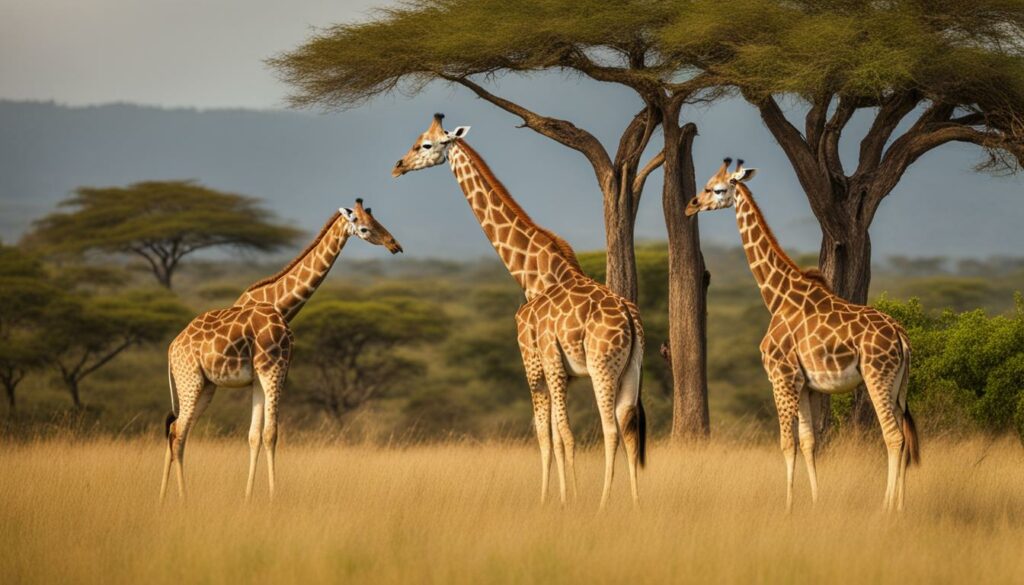
Conclusion
Giraffes are facing significant threats to their survival, including habitat loss and poaching. It is crucial to take action and protect these majestic creatures. By implementing effective conservation efforts, we can ensure the long-term survival of giraffes and preserve their important role in ecosystems.
Habitat protection plays a vital role in giraffe conservation. Preserving their natural habitats is essential for their well-being and the overall health of the ecosystem. Anti-poaching campaigns are also crucial to combat the illegal hunting of giraffes for their skin, meat, and other body parts.
Public awareness is key to giraffe conservation. Educating people about the importance of protecting giraffes and their habitats can help generate support and inspire action. Together, we can make a positive impact on the future of these incredible animals.
Are the Conservation Efforts for Giraffes Similar to Those for Elephants?
Are the key conservation efforts for elephants similar to those for giraffes? Both species face significant threats in terms of habitat loss, poaching, and human-wildlife conflict. Conservation initiatives aim to protect and restore their habitats, enforce anti-poaching measures, and raise awareness about their importance. Collaborative efforts involving stakeholders and global conservation organizations are crucial to ensuring the survival and well-being of these magnificent animals.
FAQ
What are the key conservation efforts to protect giraffes?
The key conservation efforts to protect giraffes include habitat protection, anti-poaching campaigns, relocation programs, and conservation initiatives.
What is the importance of giraffes in ecosystems?
Giraffes play a crucial role as keystone herbivores in ecosystems. They promote the growth of a greater range of plant species through their feeding behavior, which opens up areas of habitat and distributes seeds.
What are the threats to giraffes and their conservation status?
Giraffes face threats such as habitat degradation, poaching, and climate change. They are now considered vulnerable to extinction and are listed on the IUCN Red List.
What conservation efforts are being made to protect giraffes?
Conservation efforts include habitat protection, anti-poaching campaigns, reforestation of key areas with acacia trees, education and outreach programs, scientific research, and social studies.
What giraffe conservation initiatives does WSO Friend of the Earth undertake?
WSO Friend of the Earth carries out various activities to protect giraffes, including raising awareness about the threats they face, launching petitions, raising funds, certifying products from sustainable agriculture, and collaborating with conservation programs. They also participate in Earth Day campaigns to promote the conservation of giraffes and other species.
Why is giraffe conservation important?
Giraffe conservation is important to protect and preserve these majestic creatures. Through habitat protection, anti-poaching campaigns, and public awareness, we can ensure the long-term survival of giraffes and their important role in ecosystems.

